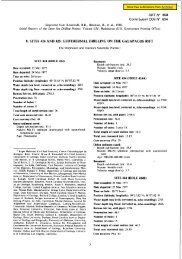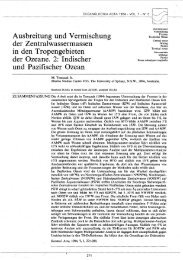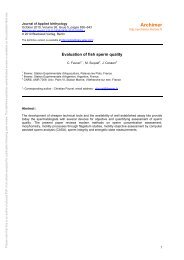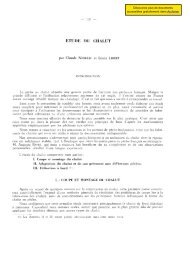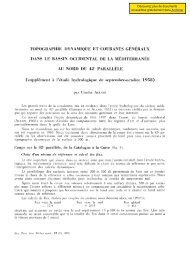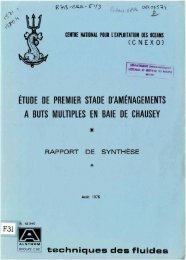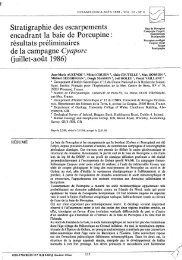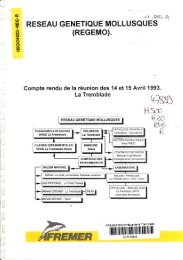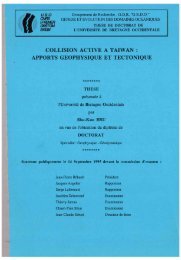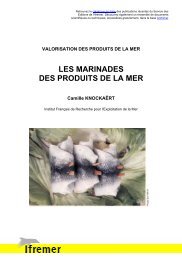Contribution à l'étude de virus de mollusques marins apparentés ...
Contribution à l'étude de virus de mollusques marins apparentés ...
Contribution à l'étude de virus de mollusques marins apparentés ...
Create successful ePaper yourself
Turn your PDF publications into a flip-book with our unique Google optimized e-Paper software.
(Table 1). 100% mortality in this group also occurred on day 13, while the presence of <strong>virus</strong> particles<br />
<strong>de</strong>tected by transmission electron microscopy was found in 0% larvae on day 6 and 100% larvae on<br />
day 8. For larvae from Marennes at 25-26'C, 29% animais exhibiting nuclear lesions were observed on<br />
day 6, while viral particles are found in 100% larvae by transmission electron microscopy on the sa me<br />
day. In this group of larvae from Marennes, 100% mortality occurred on day 8, but no analysis by light<br />
or transmission electron microscopy cou ld be performed since ail larval shells got empty. For larvae<br />
from Arcachon at 25-26'C, 100% larvae exhibiting nuclear lesions, observed by light microscopy,<br />
100% larvae containing <strong>virus</strong> particles and 100% larval mortality'were found on day 6.<br />
Discussion-conclusion<br />
ln the present study, effects of temperature were investigated by comparing survival and growth rates<br />
of C. gigas spawns reared at either 22-23'C or at 25-26'C. These results were related to the<br />
histological and ultrastructural examination of oyster larvae. Although samples of ail sets of oyster<br />
larvae were fixed each day, we have performed transmission electron microscope analysis only for<br />
samples corresponding to the <strong>de</strong>velopment of mortalities. Although it was difficult to handle numerous<br />
analysis by this method, this procedure enabled to compare survival rates and observations of nuclear<br />
lesions and viral particles. Moreover, observation of later viral infection cou Id not be performed as<br />
infected cells <strong>de</strong>tach from the larvae and few days after the beginning of the infection, the shells of the<br />
oyster larvae got empty.<br />
Viruses related to the family Herpesviridae were previously <strong>de</strong>scribed in Pacific oyster, C. gigas, larvae<br />
(Nicolas et al., 1992; Hine et al., 1992) and associated to high and sud <strong>de</strong>n mortalities occurring early in<br />
oyster larvae <strong>de</strong>velopment, usually between the 6th and the 8th day post-fertilization. But sometimes<br />
100% larval mortalities associated with herpes<strong>virus</strong> infection were observed as soon as the 4th day<br />
post-fertilization (T. Renault, personal communication). These results point out the importance to check<br />
survival rates of oyster larvae daily. But more, we tned to relate these survival rates with the presence<br />
of lesions associated with herpes<strong>virus</strong> infection. In<strong>de</strong>ed, Nicolas et al. (1992) and Renault et al.<br />
(1994b) previously <strong>de</strong>scribed ·the main histological changes in the herpes<strong>virus</strong> infected larvae as<br />
105



